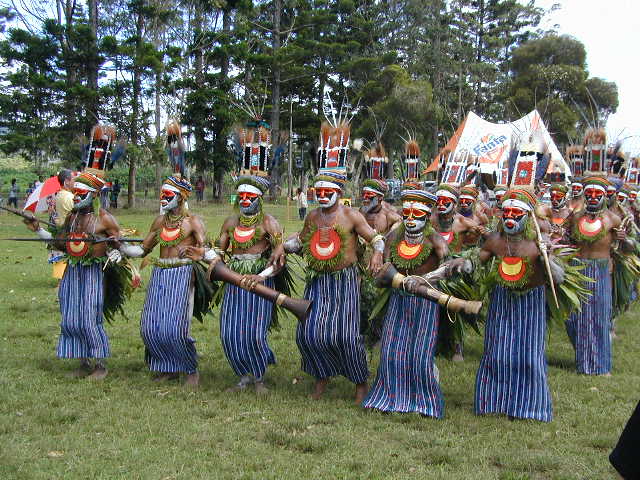
My Qantas flight from Brisbane to Port Moresby was fairly empty and quite comfortable. On arrival, I joined the long line for people who needed visas. I noticed that it wouldn't have saved me any time to have gotten my visa before leaving the U.S. as the line for visa holders was unattended. And I certainly didn't qualify as a PNG resident. In the end, the process took under an hour and cost PGK 25. (I should note that the exchange rate was roughly 3 PGK = 1 USD. I've been told that if you don't have kina, they will take U.S. or Australian dollars, but I'd chased all over Brisbane getting kina, so it didn't come up.) A couple who were also on my tour and I met our tour leader, Carolyn, were given our hotel room keys and were whisked off to the Airways Motel. The bus to the hotel was fairly decrepit, but it was a short ride on a decent road. The hotel proved to be quite comfortable - definitely international class. The entire group met for dinner that night at the poolside restaurant. The restaurant featured a buffet with some local dishes but more Asian ones. The food was good - especially, the freshly cooked tuna skewers - but the service was rather sluggish. I was more interested in who I'd be traveling with, anyway. The group consisted of six Americans (myself included), two Germans, and a British couple who live in Hong Kong. (Carolyn is British by birth, but lives in Australia part of the year and in Italy the rest.) I'd estimate the age range from mid-30's to over 70. Not surprisingly, Papua New Guinea is hardly likely to be anybody's first destination, so everyone was well-traveled. Overall, it was a comfortable group to spend two weeks with.
We had an early morning flight from Port Moresby to Mount Hagen on Air Niugini. While we waited for the plane, Carolyn told us that the Pidgin word for helicopter is "mixmaster bilong Jesus." I found Pidgin quite fascinating. Reading signs out loud is generally enough to make them understandable, but the spoken language proved fairly unintelligible. Which makes this as good a time as any for a digression on PNG linguistics. Roughly a fifth of the world's languages (700-800, depending on who you believe) are spoken in PNG. In some cases, people who live in nearby villages and trade with each other do not share a common language. The general theory is that language is power and is used to retain closely guarded clan secrets. A good bit of evidence for this is the term "wantok" ("one talk") which refers to a clan grouping and implies mutual obligation among those who speak the same tongue. Pidgin has become a common language, however, and English is the language of education. In practical terms, that means that a traveler need not attempt to learn the hundreds of "tok ples" ("place talk" if you can't decipher the Pidgin) and would often not be welcome to.
Anyway, my seatmate on the flight worked for the tourism promotion authority and was interesting to talk with. He pointed out highland gardens, as well as coffee and tea plantations. He also mentioned that the Mount Hagen Show was smaller than normal this year because the recent election had made people from outside the area afraid to travel. One of the other people in our group later heard that the 340 overseas visitors were attending the show. That's a remarkably small number if you consider that this is pretty much the biggest tourism draw in the country. Of course, the limited tourism infrastructure (particularly hotel rooms) also limits the numbers. By the way, the highlands shows originated in the 1950's in an attempt to use the competitions as a replacement for tribal warfare. Unfortunately, that approach didn't work, since the losers just attacked the winners. The problem was solved by simply awarding prizes to everyone.
The Mount Hagen Cultural Show (or sing-sing) proved to be justly famous and it was well worth being one of the 340 tourists there. The first day was colorful enough, but was rather frustrating as they let everybody into the festival enclosure. Which pretty much made it impossible to take photos without other tourists in them. Despite my disapproval, I did eventually go into the enclosure as there was no other way to really see the spectacle of costumed dancers covered with shells and feathers.

There were also a couple groups from coastal areas who wore boat-shaped head dresses. Their leaders wore extremely tall headdresses. Another coastal group had headdresses with pictures of bats on them. I later learned that meant that they are members of the bat clan. In general, the coastal groups are less colorful and wear mostly white feathers.
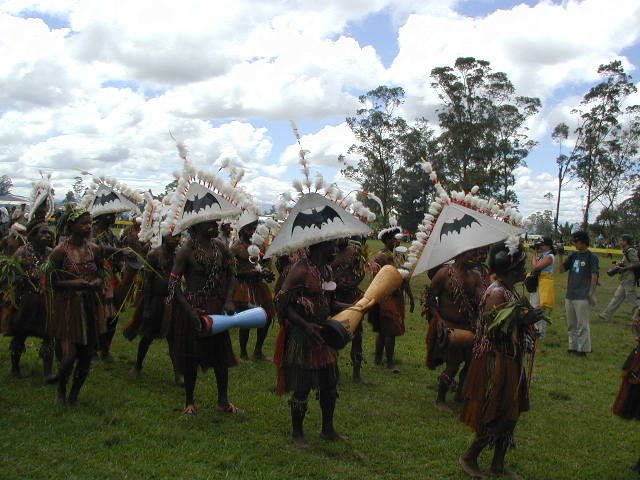
The variety of costumes was part of what made things so fascinating.
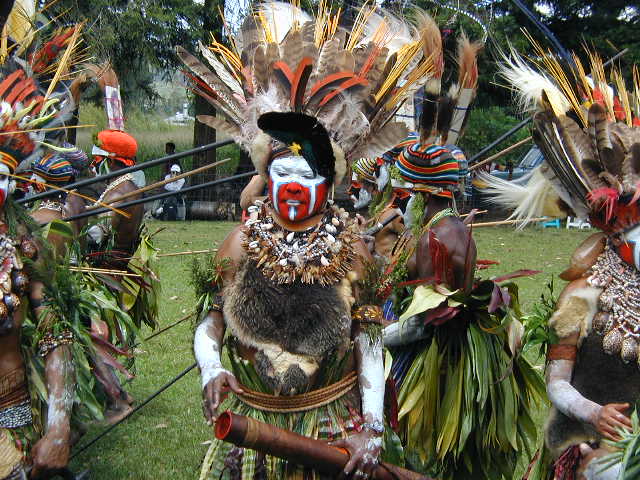
One of the great crowd favorites was a group who were made up as skeletons and who alternately attacked and cowered away from a beast or bogey man. They had a sign identifying them as the Simbu Mori cultural group. It was only near the end of the trip that we were able to learn the story. The beast is a dog that has enchanted the skeletons and they're trying to break free from the spell. Their popularity meant the crowds were too thick to get a good photo of them the first day. I did manage to photograph the other great favorite - namely, the mud men.
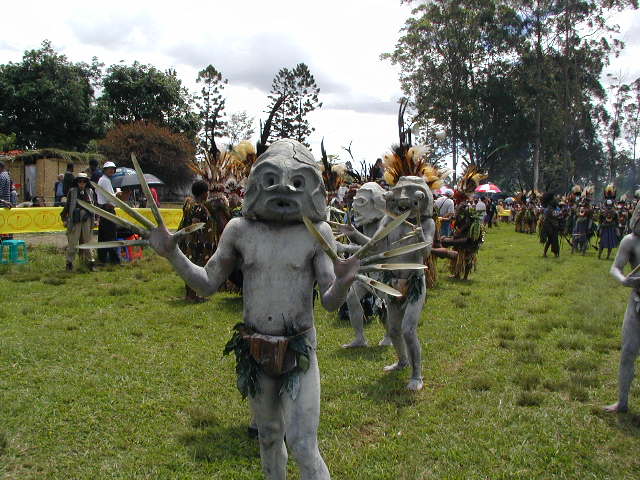
The story behind the mud men is that a tribe from a village called Asaro had lost several tribal wars. Someone got the idea that painting their bodies with clay and wearing huge mud masks would scare their enemies. This worked very well for a while and they grew wealthy. Eventually, somebody caught a mud man defecating and realized they were human. That ended the "dress up as spirits to scare the enemies" racket but the "dress up as spirits to impress the tourists" racket remains intact. Their slow movements and clicking bamboo claws are simply fascinating.
On the second day, we arrived early enough to watch the dancers getting dressed and made up. Typical highland costumes start with a bamboo belt tied around the waist, sort of like a corset. A piece of fabric (a "lap-lap") is folded in front, held in place with the belt, while bunches of leaves ("ass grass") are stuck in behind. That's followed by face painting. Finally, the head dresses are created. Each feather is placed individually each day, making for a lengthy, but interesting, process. There were some older men who were renting out feathers. The long blue feathers from the King of Saxony bird of paradise rent for PGK 2.50 a day. So participation in the show is not an inexpensive proposition in a region where rural salaries are only about PGK 5 a day.
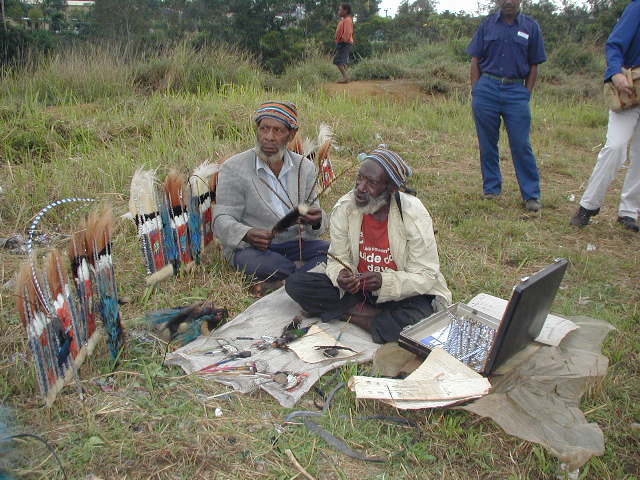
The skeleton dancers have a simpler makeup routine, getting their bones painted on.
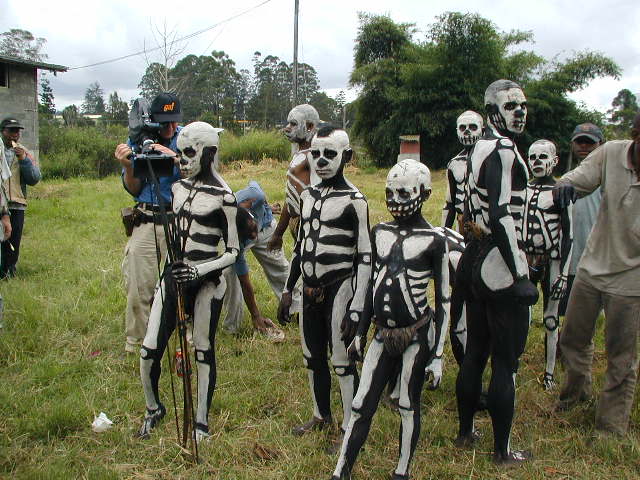
Overall, there's enough spectacle to satisfy nearly anyone. Unless, perhaps, they had some sort of aversion to cowrie shells, feathers, and cuscus fur.
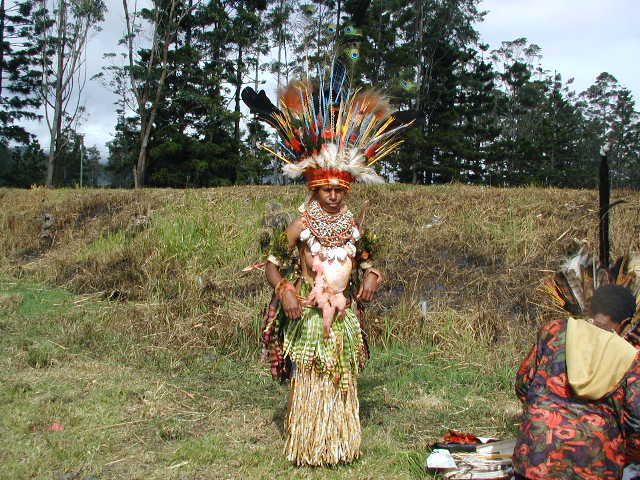
By the way, the organizers listened to complaints and did not allow anyone but the dancers into the enclosure in the morning. That made the experience far more satisfying.
After the festival and lunch, we went out to tour the city. A few people were edgy as there had been a gunfight in the town overnight, but things were quiet enough on a Sunday afternoon. We went to a supermarket, which is always interesting in other countries. The main meat for sale is mutton, but this is mostly in the form of "lamb flaps," which look like solid fat. Coffee and tea are grown locally, but often processed in Australia and reimported. We then drove past the "haus piksa" (movie theatre), various houses and schools with nice gardens, and a public cemetery that had mausoleums shaped like miniature houses. Just outside the city limits, there are a lot of betel nut markets. Betel nut is grown on the coast and is probably the most popular drug in PNG. It's chewed with lime and makes people spit huge amounts of red saliva. It also completely destroys their teeth and there is some evidence it causes oral cancer. But it's the spitting that makes it banned within the city. We were amused by the announcements on Air Niugini flights that mentioned that smoking and betel nut chewing were not allowed on the plane. By the way, the other popular drug in PNG is alcohol and it is also severely restricted in Mount Hagen. We could buy beer and wine at the hotel, but our bags were even searched on arrival at the airport to make sure we didn't have any alcohol with us.
We toured further the next day, going first to a village called either Payagona or Paiyer, depending on which guide you believe. The road was mostly paved but had huge potholes which entailed a lot of slalom driving. We passed several PMVs (public motor vehicles) which are basically trucks with a couple of wooden benches inside the truck bed and people squeezed into every available inch of space. While that's not all the unusual a form of transport in the developing world, it does make one glad to be in the relative comfort of the tour bus.
Along the way, we passed many homesteads and gardens of potatoes, sweet potatoes, corn and greens. Sugar cane is also a common crop and is tied to a stick to keep it growing straight - a practice I've never seen anywhere else. When we got the village, we had a bit of a hike up a slippery and muddy path. At the village itself, there were many things for sale - bilums (string bags), seed necklaces, axes, etc.. We went to one house which is kept as a museum. Our guide, Dominick, pointed out a stick has the bone of an ancestor in a thick central portion. The local people believe nothing happens by accident so if there's been an automobile accident, for example, they look for someone to blame. One man holds each side of the stick and they use it as a sort of dowsing rod, believing it will pull them to the guilty person.
We walked on to two spirit houses.
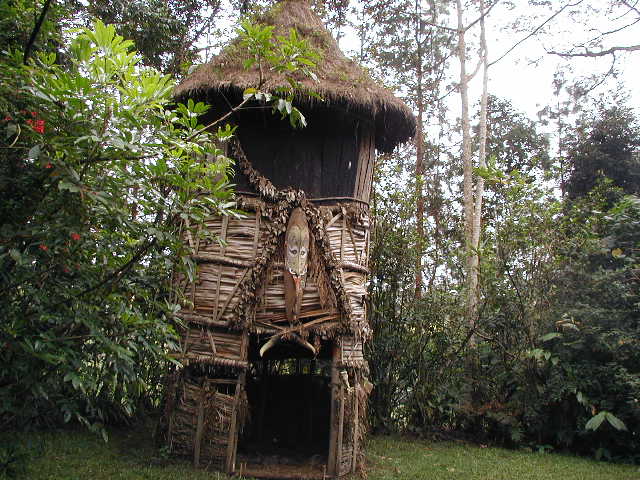
One had various stone items inside, while the other had two skulls, which we were told were the skulls of important ancestors. Incidentally, before metal implements were introduced, hard stone couldn't be carved. So if a stone was found in an unusual shape, it was thought that a spirit was in it.
Then, the elders came in. One notable detail is that bamboo necklaces are used to keep track of wealth, e.g. pigs owned, pigs given away. The longer the necklace, the richer the man wearing it is. Pigs are central to the highlands economy and are treated essentially as money. A family ideally has three houses - one for the men, one for the women, one for the pigs. If they can afford only two houses, the pigs live with the women. Pigs are also used to pay bride price. As if that isn't sexist enough, brides are given bilums by their husbands, with each one representing one of her chores, e.g. tending sweet potatoes, gathering wood, minding the pigs. They often wear several bilums on their heads, with the goods inside hanging down their backs.

By the way, the woman at the left in the picture is weaving a bilum. The work is done in a sort of half-hitch knotting stitch, worked over a thin strip of leather (or plastic these days). The large orange-ish neckpieces are decorative ways to display kina shells. Kina are mother of pearl shells and come from the coast, so came to be considered valuable when they were traded to the highlands, starting in the 1930's or so. Cowrie shells (called "toea" locally) are also valued. The PNG government cleverly named their currency after the kina and toea shells.
Later in the day, we went through the town of Mount Hagen again, stopping at the Christian Book Store to buy postcards. They had a good selection, which was fortunate as there didn't seem to be anywhere else to buy any. I was also amused by signs at stores that cautioned "no knives or weapons allowed." We went on to the marketplace. There was quite a lot for sale - sweet potatoes, other vegetables, fabric, yarn and string for making bilums, completed bilums, cuscus fur, tropical fruits (banana, pawpaw, avocado, mangosteen), leashes for pigs (tied around the pig's feet) and firewood.
Then we went to a place called Kaiap, which has village models. Frankly, I wasn't very interested, since I prefer seeing people to seeing statues of them. There were, however, a few fascinating details about the culture. One is that bodies of important people are wrapped up and hung between two poles the day before burial, so that people can pass under to pay their respects. Another is that, when someone dies, their burial plot is marked into squares with stones. Each square represents one family and if a footprint (either human or animal) is found in a square, that family is blamed for the death. If there is no footprint, the death was either caused by an outsider or the person died peacefully.
We went on to Panga cultural center, where we saw two dances. One was a highland dance, accompanied by music on flute and Jew's harp. The other was a mud man demonstration. I have to admit that I would definitely not like to run into these guys in a dark alley!
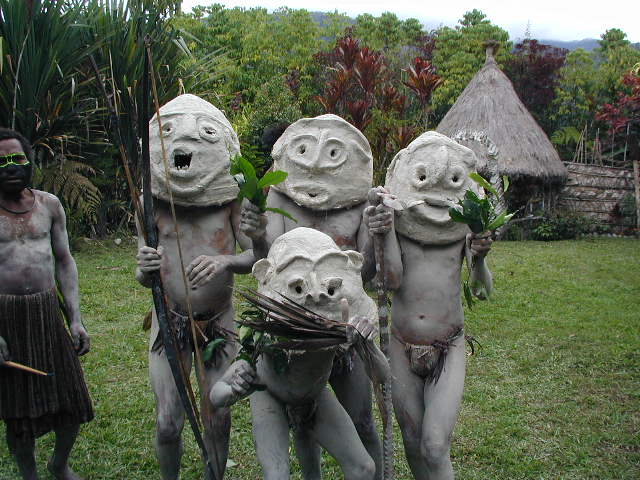
Our final stop for the day was at a coffee and tea plantation. I was surprised at how automated the tea processing was. But they were also producing a powdered tea as the end product, which I found strange.
That evening Carolyn gave us a talk on the Huli culture. Men and women have separate gardens, as well as houses, because the men are afraid to eat food grown and cooked by women. The bride goes to the women's house of the husband's family, while the man learns magic spells to protect himself from her. Eventually, the bride and groom lie outside in the garden for five days. They not only don't touch each other, but don't eat or sleep during that period. On the fifth day, he pours a foul-smelling oil on her genitals and has intercourse with her. Then, they go back to separate houses. She spends her time working in the garden, including tending pigs, which are tied to her ankles. When the husband wants more children, he unties a pig, which squeals in surprise. When the wife goes to investigate the pig's squeal, he has sex with her.
If you think that's bizarre, the even odder thing about the Huli people is the haroli bachelor cult, better known as "wigmen." Boys are taken from their mothers at about age five and raised in a the men's house. At puberty, the boys go to Huli bachelor schools. They grow their hair, twisting strings in it to make it stand straight up. They wash it in water from a river rich in copper to turn it red. After about 18 months, they shave it off and fit it to a wig form. The wig is decorated with the blue breast plate of the superb bird of paradise, yellow daisies, and parrot feathers, and they wear it from then on. There are also special wigs, worn for ceremonial events, which are shaped into two horns. Perhaps the urge to self-decoration is universal, but this is certainly a unique form of competitive hair dressing.
Carolyn also told us about a very disturbing burial ritual she saw in another part of the island. The dead people are strung up on a spit and roasted to dry them. The people drink the drippings and then hang the dried body from a nearby cliff. The only thing I could contemplate that was more gruesome was the baseball game (a Red Sox loss) I watched on ESPN at the hotel later in the evening.
Back to Last Chapter | Back to PNG Index | On to Next Chapter | Xenophilia Home
last updated 5 October 2002